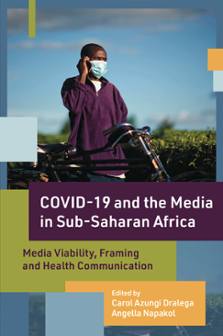
Index
COVID-19 and the Media in Sub-Saharan Africa: Media Viability, Framing and Health Communication
ISBN: 978-1-80382-272-3, eISBN: 978-1-80382-271-6
Publication date: 19 September 2022
Citation
(2022), "Index", Dralega, C.A. and Napakol, A. (Ed.) COVID-19 and the Media in Sub-Saharan Africa: Media Viability, Framing and Health Communication, Emerald Publishing Limited, Leeds, pp. 249-257. https://doi.org/10.1108/978-1-80382-271-620221014
Publisher
:Emerald Publishing Limited
Copyright © 2022 Carol Azungi Dralega and Angella Napakol
INDEX
Note: Page numbers followed by “n” indicate notes.
- Prelims
- Media Viability
- Chapter 1: Viability of Paid Subscription in Uganda: An Analysis of Chimpreports’ Paywall
- Chapter 2: Caught Between a Rock and a Hard Place: Impact of COVID-19 on Feminist Media in Uganda, Rwanda and Tanzania
- Chapter 3: Commercial Radio News Coverage of COVID-19 in Uganda: A Case Study of Central Broadcasting Service Radio
- Chapter 4: COVID-19 and the Ethiopian Newspaper Industry: Challenges and Opportunities
- Chapter 5: The Economic Impact of COVID-19 on the Print Media Industry in Zimbabwe
- Media Framing and Credibility
- Chapter 6: (Mis)Information, Sources and Credibility: Targeting Youth in Public Health Response to COVID-19 in Uganda
- Chapter 7: Framing COVID-19: Fear Appeal Messaging in Print Media in Namibia and South Africa
- Chapter 8: The Framing of COVID-19 in Uganda’s New Vision and Daily Monitor Newspapers
- Chapter 9: From Scaremongering to Messages of Hope: How State Authorities in Ghana, Sierra Leone, Ethiopia and Zimbabwe Framed the COVID-19 Crisis on Facebook
- Health Communication Discourses
- Chapter 10: Journalism and Mental Health: Ugandan Journalists’ Perspectives
- Chapter 11: Health Communication and Socio-cultural Behavioural Change in Respect to COVID-19 in South Africa
- Chapter 12: Perceptions, Myths and Misconceptions Around COVID-19 Vaccination: Vaccine Hesitancy and Uptake among Priority Groups in Uganda
- Chapter 13: COVID-19 Lockdown, Information Access and Use Among African Diaspora in Norway
- References
- Index